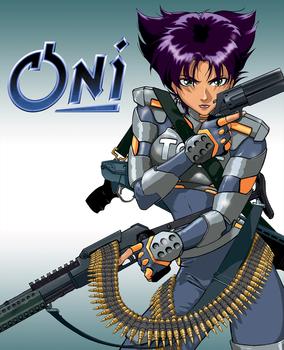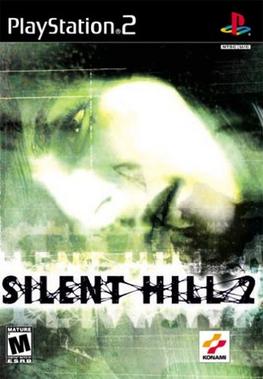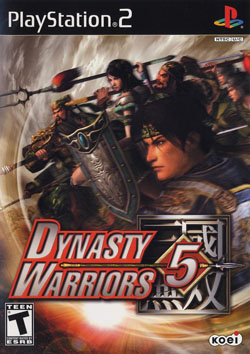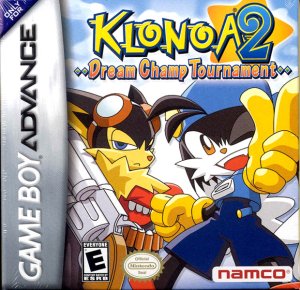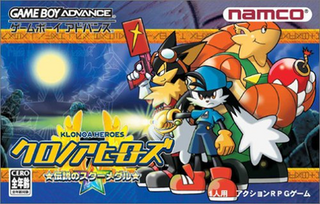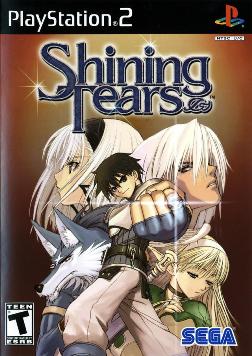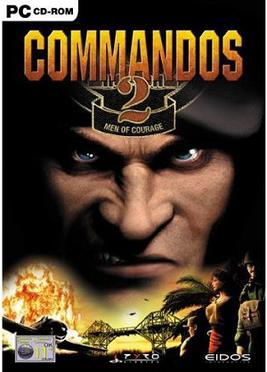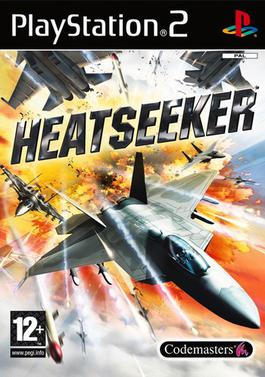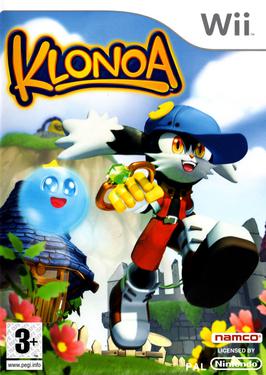Characters
The protagonist of the game is Klonoa, known by the people of Lunatea as the "Dream Traveler," one who is summoned to save unbalanced dream worlds. Throughout most of the game, he is accompanied by Lolo, a priestess in training. She has continuously failed the test to become a full-fledged priestess, but is asked by the High Priestess of the Goddess Claire to aid Klonoa in his journey to save Lunatea. She is hinted to have feelings for Klonoa. In the game, she provides the energy of Klonoa's ring. Klonoa is also joined by the dog-like creature Popka, who acts as the rude but charismatic sidekick of Lolo. Despite his rough exterior, Popka cares greatly for Lolo, which is shown to great effect during a pivotal scene later in the story.
Early in the game, the trio seek the aid of the enigmatic prophet, Baguji, who apparently predicted Klonoa's arrival and directs the team throughout the early parts of their journey.
The game's primary antagonist is the pirate Leorina, a former priestess who eventually lost her patience and set off to gain "The power of the gods." She is accompanied by Tat, a floating cat-like creature who has the power to split herself into two beings. She shows a liking to Klonoa at the beginning of the game, giving off a few tips to Klonoa when he is pursuing her.
Story
The story begins with Klonoa, in what appears to be a dream, being asked for help by an unknown silhouette. Klonoa suddenly starts falling into water. A flying ship, carrying sky pirates Leorina and Tat, appears above him. Before they can take his ring, the priestess-in-training Lolo and her sidekick Popka appear and they fly off, not wanting to risk losing the ring. Klonoa wakes up and is greeted by Lolo and Popka. Klonoa introduces himself, and Lolo mentions that Klonoa is "the name of the Dream Traveler". Klonoa is confused, but before he could ask anything, they are interrupted by a Digon attack that they barely evade. With Lolo powering Klonoa's ring, they make their way across the Sea of Tears and ring the Spirit Bell. Lolo believes she rang the bell, saying she can become a full-fledged priestess now. They then decide to speak to the prophet Baguji, and Klonoa learns that he is in the world of Lunatea.
While the trio speak with Baguji, Klonoa learns about the bells of its four kingdoms, as well as the looming threat of a fifth bell that would cause chaos throughout the land if it were to appear. They then make their way to the High Priestess, where Lolo is granted the title of a priestess. Klonoa learns he must get the elements from the giant bells spread throughout Lunatea in order to stop the fifth bell from appearing. Throughout their journey, their progress is impeded by Leorina and Tat, who at first try to steal Klonoa's Wind Ring but eventually end up gaining data from it in order to create a fake ring, which Leorina uses to gain one of the elements for herself.
At the Maze of Memories in Mira-Mira, Klonoa ends up finding out about Lolo's past; prior to his arrival in Lunatea, she was bullied and mocked by her peers, and after hearing about his foretold arrival from Baguji, decided that she would accompany Klonoa in order to show her peers that she has what it takes to become a priestess. Having been forced to relive this memory, Lolo breaks down and apologizes for everything, with Klonoa noticeably feeling bad for her. Later, Klonoa ends up struggling against the last element's guardian, as the guilt-racked Lolo is on the cusp of giving up, believing that she isn't qualified to save the world, and as a result is unwilling to power the Wind Ring. However, Popka gives Lolo a pep-talk, telling her that "qualifications don't matter" and that Klonoa, despite not being from Lunatea, is giving it his all to save it because he knows that to keep trying is the right thing to do. Lolo ultimately regains her confidence and lends a helping hand to Klonoa.
After collecting the element of indecision, the trio head back to Baguji with three out of the four elements collected. However, they instead end up meeting with Leorina, who disguised herself as Baguji and manages to steal the remaining elements. Leorina disappears, and Klonoa, Lolo and Popka head back to the High Priestess, where they learn that Leorina used to be a priestess in the past. However, she was impatient and ended up leaving the temple altogether, deciding to find her own way of achieving power. In the present, Leorina had gone to the Sea of Tears in order to use the elements' power to re-emerge the fifth bell, which she soon rings just as Klonoa arrives, opening the gate to the fifth kingdom known as the Kingdom of Sorrow, Hyuponia.
After catching up with her, Leorina explains that with the power she has, she'll get her revenge on Lunatea, but instead, she gets cursed by sorrow, turning into a giant silver bird-like creature. After Klonoa saves her, she realizes she was a pawn and she and Tat decide to help Klonoa. The heroes arrive in Hyuponia and eventually end up face to face with its ruler, the King of Sorrow, who tells them that the fifth kingdom was always there, but that they "put a veil over it" and refused to see it, explaining that he only wants to reconnect the Kingdom of Sorrow with the rest of Lunatea so its inhabitants can remember sorrow. It is revealed that the King of Sorrow led the heroes through false prophecies and made them false saviors by using the seer Baguji as an illusion before finally revealing that he was the one who summoned Klonoa to Lunatea, as well as the mysterious voice that wanted Klonoa's help. In the end however, the king attacks Klonoa instead, claiming it will be so the Dream Traveler could "atone for Lunatea's sins". Leorina aids Klonoa by lending him the other elements from her fake ring to Klonoa's Wind Ring, and the King of Sorrow is ultimately defeated. Upon asking for help one last time, Klonoa rings the bell and reconnects Hyuponia with Lunatea.
Klonoa promises the dying King of Sorrow that the world would remember sorrow. The king, content with this outcome, disappears and fades away into particles of light, granting Klonoa the element of sorrow. Sometime later, Leorina and Tat decide to restore the Kingdom of Sorrow, and Lolo gives up her title as a priestess, aiming to regain it on her own. Klonoa decides to return to his home world, and Lolo is disappointed that he has to leave. She initially tells him that it's fine and that she'll be okay because "[she's] going to do [her] best", but ends up breaking down shortly after saying that Klonoa taught her that it was okay to cry so long as she kept doing so. After asking him if it was okay to cry now, she runs up to him and hugs him, crying audibly and begging him not to leave. Klonoa tells Lolo that as long as she doesn't forget the sadness of this moment, they will always be together. After letting out her final tears, Lolo lets go of Klonoa. Klonoa then bids her farewell, thanking her for everything, and walks away as Lunatea ripples into a white void.
In the credits, it is revealed that the inhabitants of the four kingdoms in Lunatea are now moving about freely to the other kingdoms, with some of them assisting Leorina and Tat in rebuilding the Kingdom of Sorrow while others are exploring the other four kingdoms with curiosity and wonder.



